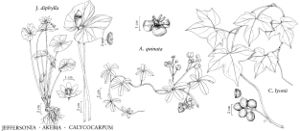Difference between revisions of "Menispermaceae"
FNA>Volume Importer |
imported>Volume Importer |
||
| (One intermediate revision by one other user not shown) | |||
| Line 76: | Line 76: | ||
|publication year= | |publication year= | ||
|special status= | |special status= | ||
| − | |source xml=https:// | + | |source xml=https://bibilujan@bitbucket.org/aafc-mbb/fna-data-curation.git/src/bb6b7e3a7de7d3b7888a1ad48c7fd8f5c722d8d6/coarse_grained_fna_xml/V3/V3_734.xml |
}}<!-- | }}<!-- | ||
-->[[Category:Treatment]] | -->[[Category:Treatment]] | ||
Revision as of 00:04, 28 May 2020
Vines and lianas [shrubs or trees], deciduous, woody at least at base, twining or clambering. Stems striate, without spines. Leaves alternate, simple; stipules absent; petioles present. Leaf blade palmately veined, often palmately lobed. Inflorescences axillary or terminal, fascicles, cymes, racemes, or panicles, flowers pedicillate. Flowers unisexual, staminate and pistillate on different plants, never showy; sepaloid bracteoles absent; perianth hypogynous, segments distinct or fused, not showy, greenish white to white or cream, imbricate or valvate. Staminate flowers: sepals usually 6, not spurred; petals usually 6, sometimes absent, distinct or connate, ± concave, frequently minute; nectaries absent; stamens either opposite petals and equal in number, or numerous; filaments distinct or united; anthers dehiscing longitudinally [or transversely]; pistillodes sometimes present. Pistillate flowers: sepals (4-)6, sometimes reduced to 1; petals often 6 or reduced to 1, ± concave, usually minute; nectaries absent; staminodes frequently present; pistils 1-6; ovules 2, aborting to 1, amphitropous; style often recurved; stigma entire or lobed. Fruits drupes, straight or horseshoe-shaped; exocarp membranous; mesocarp ± pulpy; endocarp (stone) bony, often warty, ribbed. Seeds never stalked; endosperm present or absent; embryo usually curved.
Distribution
Widespread in temperate and tropical regions.
Discussion
Genera ca. 78, species ca. 525 (4 genera, 5 species in the flora).
Selected References
Lower Taxa
Illustrations
Key
| 1 | Inflorescences with bracts; pistillate flowers: sepal 1, petal 1, pistil 1; staminate flowers (not known in flora): sepals 4, petals 4, connate, stamen filaments fused, anthers 1-locular; leaf blade usually reniform; drupes pubescent | Cissampelos |
| 1 | Inflorescences with minute bracts or bracts absent; pistillate and staminate flowers: sepals 6-9, petals distinct when present, stamen filaments distinct, anthers 2-4-locular, pistils 2-6; leaf blade various shapes, rarely reniform; drupes glabrous. | > 2 |
| 2 | Petals absent or vestigial; anthers 2-locular; ovary ellipsoid to fusiform; stigma multicleft; leaf blade not mucronate at apex, surfaces sparsely bristly or glabrous; endocarp smooth, excavate on 1 side, margins erose | Calycocarpum |
| 2 | Petals well developed; anthers 4-locular; ovary slightly asymmetrically pouched; stigma entire or slightly lobed; leaf blade mucronate at apex, surfaces soft-pubescent or glabrous; endocarp warty and ribbed, depressed but not excavate. | > 3 |
| 3 | Inflorescences usually racemes or racemose panicles; petals 6, to 2 mm, with auriculate basal lobes; stamens 6; pistils 6; leaf blades not peltate | Cocculus |
| 3 | Inflorescences usually of well-developed panicles; petals (4-)6(-12), to 4 mm, without auriculate basal lobes; stamens 12-36; pistils (2-)3(-4); leaf blade usually peltate, petiole inserted near margin | Menispermum |

